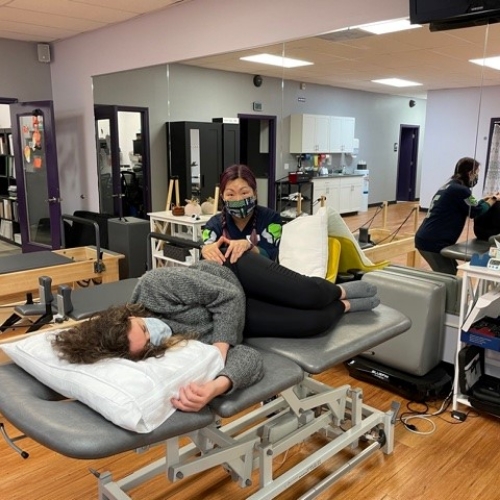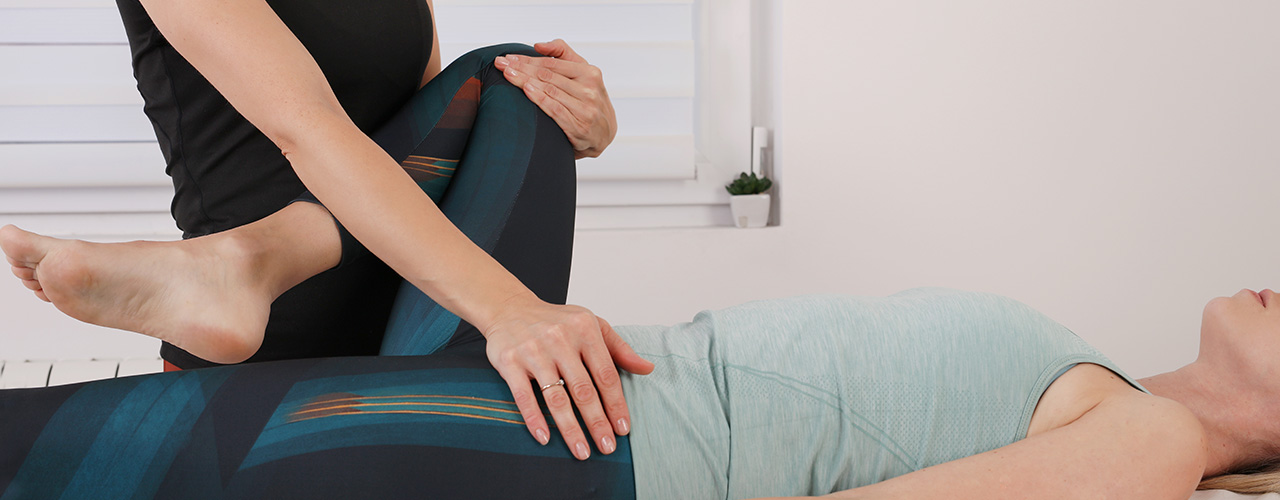Discover the Transformative Benefits of Pelvic Therapy for Your Recovery
Our holistic programs may be the solution you’ve been searching for!
Pelvic floor therapy is a type of physical therapy focused on the group of muscles and tissues that form a sling-like structure at the bottom of the pelvis. These muscles support the bladder and uterus, extending from the pubic bone to the tailbone and from side to side between the bones in your bottom that you sit on. Our physical therapists in Normandy Park, WA are specifically trained in pelvic floor assessment and treatment, and we use a holistic, patient-centered approach to therapy. We see you as whole person, considering your psychological, physical, and cognitive well-being in the healing process! Call Kintsugi Physical Therapy & Wellness today to learn more and schedule your first appointment!

Conditions That Pelvic Floor Therapy Treats
Our physical therapists in Normandy Park, WA treat a wide range of conditions with our comprehensive approach to care. The type of therapy that we prescribe will depend on the symptoms and condition that you’ve been experiencing.
Conditions that can be improved with pelvic floor physical therapy include:
- Urinary incontinence and bowel problems: Loss of bowel and bladder control, including leakage or increased urgency. Symptoms can also be mild or severe, varying from a subtle loss of urine after sneezing, coughing, or laughing to a complete lack of urination control and/or constipation.
- Interstitial cystitis (IC): A chronic and painful bladder condition. Symptoms of IC include pelvic pain, bladder pain, uncomfortable pressure, and a frequent urge to urinate.
- Pelvic and lower abdominal pain: Pain or discomfort, ranging from a sharp jab to a dull ache, in the lowest part of the abdomen and pelvis. People may also experience pain in the genital area and/or rectum.
- Pregnancy/postpartum pain: During the pre and postpartum period, women may experience pelvic pain, urinary incontinence, fecal incontinence, low back pain, and separation of the abdominal muscles (diastasis recti).
- Pelvic organ prolapse: When the pelvic organs drop from their normal position.
- Sexual dysfunction: Pelvic floor symptoms can cause reduced sexual arousal, infrequent orgasm, and dyspareunia (genital pain that occurs before, during, or after intercourse).
- Erectile dysfunction (ED): ED occurs when you cannot get or maintain an erection during intercourse. Pelvic muscle pain or dysfunction can cause ED; however, erectile dysfunction is a complex condition that can stem from a number of factors.
If you have been diagnosed with any of these conditions or are experiencing related symptoms, pelvic floor physical therapy might be right for you! Call Kintsugi Physical Therapy & Wellness today to book a consultation with one of our specialists.

Our Holistic Approach to Pelvic Floor Therapy
At Kintsugi Physical Therapy & Wellness, we treat pelvic floor dysfunction non-surgically and without medication management. We will begin with a comprehensive assessment of your condition, current symptoms, and other health or lifestyle factors. This initial exam is your time to share details and express concerns with our providers. We prioritize privacy during sessions for pelvic health issues, with one-on-one therapy in a private setting.
Following the initial consultation, your therapist will design a treatment plan that is tailored to your unique needs and will successfully meet recovery goals. Our holistic approach addresses all aspects of your health beyond just the symptoms you present.
Treatment options typically include:
- Pelvic floor exercises: During treatment at Kintsugi Physical Therapy & Wellness, our therapists will address the tight muscles in your pelvic floor. In addition, we will teach you how to stretch these muscles and improve coordination.
- Relaxation techniques: Relaxation techniques are often recommended to treat pelvic floor dysfunction, such as meditation, yoga, warm baths, or acupuncture.
- Biofeedback: Our physical therapists may use biofeedback to help retrain your muscles. Biofeedback involves special sensors that monitor your pelvic floor muscles as you move them.
- Bladder and bowel retraining: Our therapists will help you develop a schedule for urination and bowel movements. This helps improve bladder and bowel function and reduce incontinence.
- Education and lifestyle modifications: Part of treatment includes education and lifestyle modifications, which consist of proper posture, diet, and other lifestyle factors that can affect pelvic floor health. Our PTs may also recommend modifications to daily activities or exercises that may be exacerbating symptoms.
Restore Function and Reduce Pain for a Happier, Healthier Life
We understand that pelvic floor dysfunction can be a sensitive and personal issue, and we strive to create a safe and comfortable environment where you can feel confident and supported throughout your treatment journey with Kintsugi Physical Therapy & Wellness. Our goal is to restore functions and reduce pain so that you can achieve a happier, healthier life. Reach out to us in Normandy Park, WA today to book an appointment!
Your Next Steps…
Request An Appointment
Receive A Custom Treatment Plan
Work Hard and Progress In Your Recovery
Recover & Enjoy Life Pain-Free!

